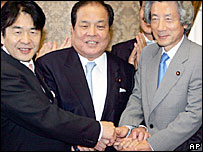Japan on the Brink of the Abyss? [Updated]
Andrew DeWit
The economic outlook in Japan is very grim, as these brief overviews (links below) indicate. Right now, Japan has the worst growth outlook in Asia. That is a surprising fact, if one recalls that this is a country presumably dusting itself off from the collapse of its own bubble nearly two decades ago. After such a long period of economic crisis, Japan should be renovated and ready to thrive. But instead, it may be in worse shape than even the US (though clearly not Iceland and much of Eastern Europe). Japanese financial institutions were not big players in the CDOs, CDSs and the other toxic assets that have ravaged the capital bases of banks in the US and much of Europe. Rather, Japan’s key policy failure would appear to be over-reliance on exports as the engine of growth, while hoping that the fruits of this growth would trickle down into the rest of the economy and bolster demand. But in the rest of the economy, deregulation of labour and other markets had seen firms shifting to insecure employment (especially part-time and contractual staff) and rolling back pay, thus crimping the level of demand. And that weak domestic demand was of course blunting domestic-oriented businesses’ incentives to invest (cf. export-oriented businesses’ incentives to invest). With the startling 35% drop in exports in December 2008, it’s as if someone kicked the chair away from a man who was standing on one to test out what it felt like to have a noose around his neck.
An unemployed man rests in a Tokyo Park, July 29, 2008
The LDP and PM Aso Taro are of course trying to assert that the problem is global, a once-in-a-century event. But the pattern of fallout varies among low toxic-asset countries (especially Asian), notably in accordance with their degree of reliance on the trade bubble. Japan seems to be suffering the legacy of the Koizumi Junichiro and Takenaka Heizo “structural reforms,” in that the reformists were content to rely on exports (stimulated by ultra-low interest rates) and to use deregulation, privatization and (to some extent) tax cuts in order to eviscerate the public sector’s role and let the market determine the strategic focus of the economy. They were loath to look at the Scandinavian model as a guide to building safety nets for encouraging labour mobility and laying a strong floor as the basis of the domestic economy (also by investing in education and encouraging higher remuneration and professionalization in elder care and other growth sectors). They disparaged the role of the public sector in framing markets and in sketching the strategic focus of the overall economy, such as in deciding targets in energy and environmental areas and thus giving incentives for market actors to achieve.
Takenaka (left) and Koizumi (right) celebrate the victory in privatizing the Japan Post office
In the most recent edition of the Japanese weekly, ekonomisuto (economist), Koizumi’s neoliberal brain Takenaka Heizo still trumpets the small state and deregulatory nirvana. Elsewhere he has blamed Japan’s current crisis on insufficient deregulation.
But he and Koizumi were champions of low interest rates, even though these rates cost domestic savers some JPY 35 trillion per year (nearly 12% of their previous income). This was not only a subsidy to the export industries. Low rates also helped keep zombie firms (about 20% of small and medium enterprises) in business, since low interest allowed them to roll over their loans even though they were effectively broke. A strategic investment focus from the central government, during the Koizumi “structural reform” years, would have put momentum into the recovery on the domestic side and allowed the ratcheting up of interest rates while softening the damage from failures of zombie firms that simply couldn’t modernize fast enough as their low-interest security blanket was lifted. The extra income for savers (from normalization of interest rates) would have bolstered the domestic economy enough to provide new employment opportunities to the labour and capital shed by many inefficient enterprises and retraining could have been offered to the hard-core unemployed.
That’s all hindsight of course, but it beats the hindsight on offer recently: many of the newly anti-market crowd are trumpeting “Edo” (old Tokyo) society and even the Jomon Era (14,000-400 BC) as models for the present, lauding their closeness to nature, stability, and community values. One Jomon booster is a former free-market cheerleader who got his economics PhD from Harvard and has been big in government deliberation councils. Japan’s public debate still hasn’t cut through the nonsense of idealizing the “free market” or the “unique Japanese” and come to focus on what the public sector of this advanced, industrialized country needs to be doing in the midst of the worst economic crisis since the 1930s.
See Edward Hugh, Japan’s Grim And Bear It 2009 Outlook, Japan Economy Watch, January 26, 2009.
See Megan Ainscow, Retail Sales Set To Plummet As Economy Takes a Turn for the Worst, CEP News.
See the commentary and update at Naked Capitalism on February 2, 2009.
Andrew DeWit is Professor of the Political Economy of Public Finance, Rikkyo University and an Asia-Pacific Journal coordinator. With Kaneko Masaru, he is the coauthor of Global Financial Crisis published by Iwanami in 2008.
He wrote this commentary for The Asia-Pacific Journal. Posted on January 29, 2009.
Recommended citation: Andrew DeWit, “Japan on the Brink of the Abyss?” The Asia-Pacific Journal, Vol. 5-4-09, January 29, 2009.




![Japan on the Brink of the Abyss? [Updated]](https://apjjf.org/wp-content/uploads/2023/10/unemployed.jpg)

